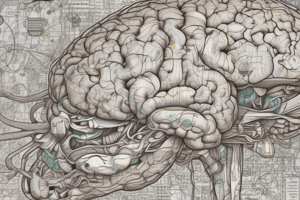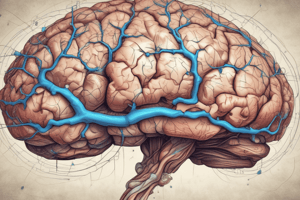Podcast
Questions and Answers
What are the functions of the lateral geniculate nuclei of the thalamus?
What are the functions of the lateral geniculate nuclei of the thalamus?
Separates out and relays information on movement through the magnocellular pathway and separates out and relays information on color through the parvocellular pathway. The P channel also emphasizes visual inputs from regions of high cone density, sharpens contrast information, and segregates axons from the two eyes for depth perception by sending contralateral and ipsilateral signals.
What is the role of the P channel in the thalamic processing?
What is the role of the P channel in the thalamic processing?
The P channel emphasizes visual inputs from regions of high cone density, sharpens contrast information, and segregates axons from the two eyes for depth perception by sending contralateral and ipsilateral signals.
How does the lateral geniculate nuclei of the thalamus contribute to depth perception?
How does the lateral geniculate nuclei of the thalamus contribute to depth perception?
It contributes to depth perception by segregating axons from the two eyes and sending contralateral and ipsilateral signals.
Explain the role of the prestriate cortices in visual processing, including the types of visual input they process and their extensions into other regions of the brain.
Explain the role of the prestriate cortices in visual processing, including the types of visual input they process and their extensions into other regions of the brain.
Describe the cell types in the visual cortex and their respective functions.
Describe the cell types in the visual cortex and their respective functions.
Define visual acuity and explain how it is measured.
Define visual acuity and explain how it is measured.
What is the significance of the ability to distinguish between objects in visual acuity?
What is the significance of the ability to distinguish between objects in visual acuity?
Explain the visual processing system's spatial resolution and its importance in visual acuity.
Explain the visual processing system's spatial resolution and its importance in visual acuity.




